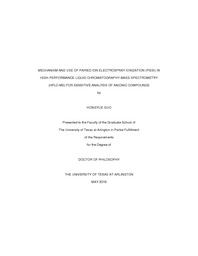
ATTENTION: The works hosted here are being migrated to a new repository that will consolidate resources, improve discoverability, and better show UTA's research impact on the global community. We will update authors as the migration progresses. Please see MavMatrix for more information.
Show simple item record
| dc.contributor.advisor | Armstrong, Daniel W. | |
| dc.creator | Guo, Hongyue | |
| dc.date.accessioned | 2017-09-13T14:27:18Z | |
| dc.date.available | 2017-09-13T14:27:18Z | |
| dc.date.created | 2016-05 | |
| dc.date.issued | 2016-04-18 | |
| dc.date.submitted | May 2016 | |
| dc.identifier.uri | http://hdl.handle.net/10106/26917 | |
| dc.description.abstract | In recent years, the paired ion electrospray ionization (PIESI) technique has been emerged as a promising alternative to overcome the inherent low sensitivity of negative ESI-MS. The current research focused on the further understanding of the mechanism of the enhanced sensitivity in PIESI based on previous studies, as well as novel applications of PIESI in sensitive and selective analysis of challenging anionic compounds.
Specifically, this dissertation describes research in two areas:
1) The mechanism of PIESI in sensitive detection of anions was further investigated using two rational designed surface-active ion-pairing reagents. As compared to their corresponding non-surface-active ion-pairing reagents, the detection sensitivities obtained with surface-active ion-pairing reagents were further enhanced. It was found that surface activity plays a critical role in the detection sensitivity for anions with PIESI.
2) Novel applications of PIESI in trace analysis of anionic sugars, abused drug metabolites and dicamba residues were demonstrated in Chapter 3, 4 and 5 respectively. Chapter 3 demonstrates that PIESI provided LODs for anionic sugars by one to two orders of magnitude lower than negative ESI. Chapter 4 describes the development of a HPLC-MS/MS method based on PIESI for trace analysis of abused drugs in urine by detecting their glucuronate and sulfate conjugates. As compared to other reported negative ESI based methods, one to three orders of magnitude improvement in detection sensitivity was obtained with PIESI. Chapter 5 describes the application of PIESI for analysis of dicamba residues in complex raw agricultural commodities with enhanced sensitivity and selectivity. The performance of PIESI in reduction of matrix effects was demonstrated in Chapter 6. As compared to negative ion mode, PIESI were less susceptible to matrix effects in groundwater and urine. Overall, the PIESI strategy should be widely used for trace analysis of other types of anionic compounds and samples. | |
| dc.format.mimetype | application/pdf | |
| dc.language.iso | en_US | |
| dc.subject | Paired ion electrospray ionization (PIESI) | |
| dc.subject | Anionic compounds | |
| dc.subject | High-performance liquid chromatography mass spectrometry (HPLC-MS) | |
| dc.subject | Detection sensitivity | |
| dc.subject | Ion-pairing reagent | |
| dc.subject | | |
| dc.title | MECHANISM AND USE OF PAIRED ION ELECTROSPRAY IONIZATION (PIESI) IN HIGH-PERFORMANCE LIQUID CHROMATOGRAPHY-MASS SPECTROMETRY (HPLC-MS) FOR SENSITIVE ANALYSIS OF ANIONIC COMPOUNDS | |
| dc.type | Thesis | |
| dc.degree.department | Chemistry and Biochemistry | |
| dc.degree.name | Doctor of Philosophy in Chemistry | |
| dc.date.updated | 2017-09-13T14:27:19Z | |
| thesis.degree.department | Chemistry and Biochemistry | |
| thesis.degree.grantor | The University of Texas at Arlington | |
| thesis.degree.level | Doctoral | |
| thesis.degree.name | Doctor of Philosophy in Chemistry | |
| dc.type.material | text | |
| dc.creator.orcid | 0000-0002-9279-2513 | |
Files in this item
- Name:
- GUO-DISSERTATION-2016.pdf
- Size:
- 2.392Mb
- Format:
- PDF
This item appears in the following Collection(s)
Show simple item record


